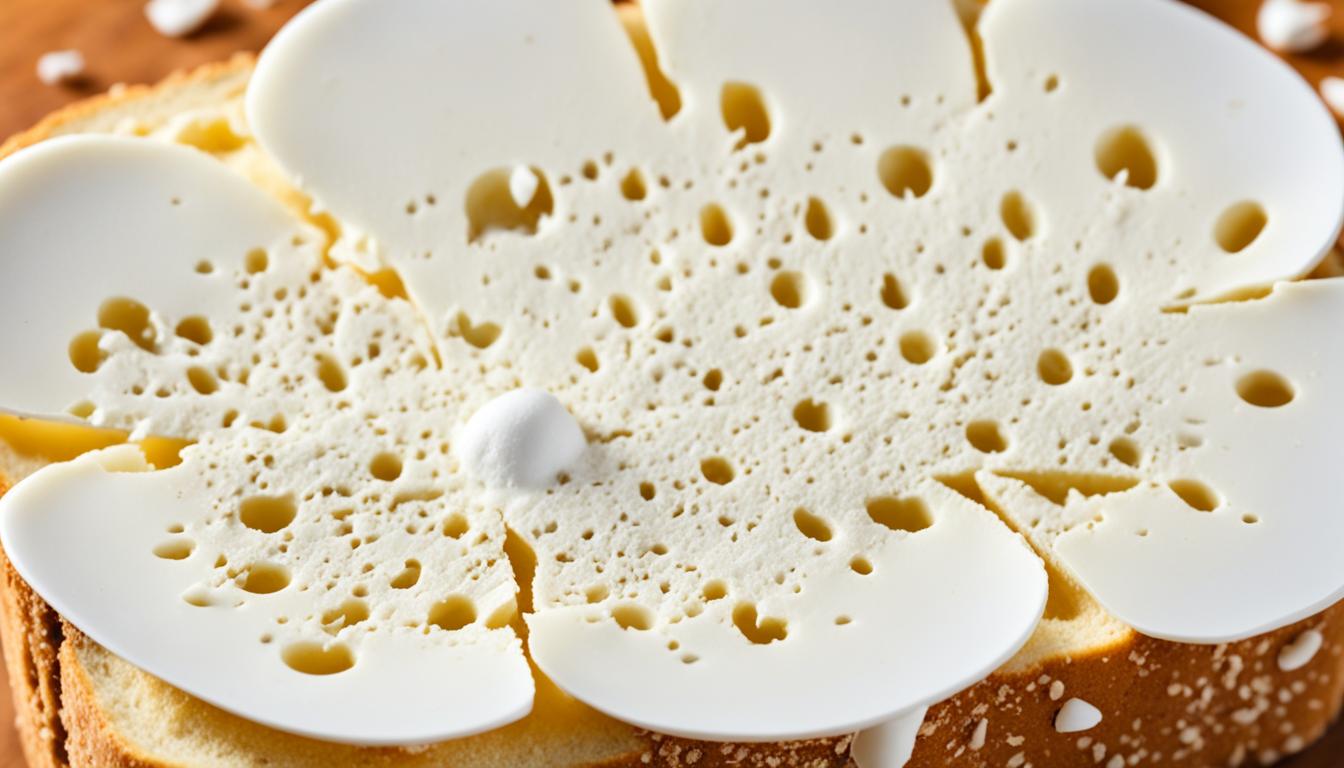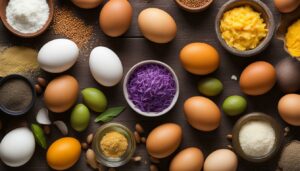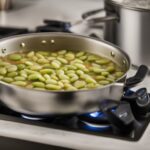Are you a bread baking enthusiast? Have you ever wondered why eggs are such a crucial ingredient in bread recipes? Well, wonder no more! In this article, we will explore the benefits of using eggs in bread and provide you with some handy tips that will take your bread baking skills to the next level.
When it comes to bread making, eggs are more than just a binding agent. They play an integral role in enhancing the texture, flavor, and overall quality of the bread. The addition of eggs to the dough results in a lighter and fluffier texture, a bouncier crumb, and a richer, more flavorful loaf.
But how exactly do eggs achieve these remarkable effects? Eggs contribute to the gluten structure of the bread dough, which is responsible for giving it its elasticity. The proteins in eggs provide strength to the gluten network, resulting in a better rise and a lighter texture.
Not only do eggs improve the texture of the bread, but they also add a richness and depth of flavor to the final product. The fat in egg yolks inhibits gluten formation, creating a looser dough that can expand and puff up more. Additionally, eggs help the dough retain gas, leading to a lighter and fluffier loaf.
Using eggs in bread recipes requires some adjustments. You need to consider the water and fat content in the dough to accommodate the addition of eggs. And while eggs are a fantastic ingredient, we recognize that there may be reasons why you cannot or choose not to use them. But fret not! There are alternative ingredients that can achieve similar effects, such as using other fats, sugars, milk, or alternative ingredients like potato starch or cornflour.
Contents
- 1 The Effects of Eggs on Dough Structure
- 2 The Impact of Eggs on Crust
- 3 Nutritional Benefits of Using Eggs in Bread
- 4 Alternatives to Eggs in Bread Recipes
- 5 The Influence of Eggs on Dough Handling
- 6 The Science Behind Eggs in Bread
- 7 The Practical Experiment: Bread with and without Eggs
- 8 The Role of Eggs in Bread Recipes
- 9 Conclusion
- 10 FAQ
- 10.1 Why are eggs essential in bread recipes?
- 10.2 How do eggs affect the structure of bread dough?
- 10.3 What is the impact of eggs on the crust of bread?
- 10.4 What are the nutritional benefits of using eggs in bread?
- 10.5 What are the alternatives to using eggs in bread recipes?
- 10.6 How do eggs influence dough handling in bread recipes?
- 10.7 What is the science behind eggs in bread?
- 10.8 What can a practical experiment comparing bread with and without eggs reveal?
- 10.9 What is the role of eggs in bread recipes?
- 11 Source Links
Key Takeaways:
- Eggs enhance the texture, flavor, and overall quality of bread.
- They contribute to a lighter and fluffier texture, inhibit gluten formation, and create a bouncier crumb.
- Eggs add richness and flavor to enriched dough.
- Adjustments are necessary when using eggs in bread recipes.
- There are alternative ingredients available for those who cannot or choose not to use eggs.
The Effects of Eggs on Dough Structure
Eggs play a crucial role in enhancing the gluten structure of bread dough. Their unique composition and properties contribute to the overall texture, elasticity, and lightness of the final loaf.
Increased Protein Content: Eggs are rich in protein, which provides structure and strength to the dough. This increased protein content supports the formation of air pockets in the dough, allowing it to rise and expand. The result is a bread with a lighter and more airy texture.
Inhibition of Gluten Formation: The fat in egg yolks inhibits the formation of gluten in the dough. Gluten gives bread its structure and elasticity, but too much gluten can result in a dense and tough texture. By incorporating eggs, the gluten formation is naturally limited, resulting in a looser dough that can expand and puff up more during baking.
Egg Whites as a Coagulant: The egg whites contain proteins that act as a coagulant, helping to set the crumb and create a bouncier and chewier texture. This coagulation process improves the overall mouthfeel of the bread.
Improved Gas Retention: Eggs also enhance the dough’s ability to retain gas. The proteins in eggs help to stabilize the air bubbles created during the fermentation process, leading to a lighter and fluffier loaf.
The strategic use of eggs in bread recipes contributes significantly to the dough structure, resulting in a satisfying texture and overall baking success.
The Impact of Eggs on Crust

Eggs greatly affect the crust of bread, playing a crucial role in achieving the desired texture and appearance. They contribute to the browning and caramelization of the crust, resulting in a crispier and more flavorful exterior. When eggs are included in bread recipes, the crust develops a beautiful golden color that adds visual appeal to the loaf.
“The crust is where the magic happens. It’s the first thing we see, touch, and taste.”
However, it’s important to note that breads containing eggs should not be baked at high temperatures, as the crust may darken too quickly. The eggs in the dough accelerate the Maillard reactions, creating a rich brown color. Baking at a moderate temperature allows for even browning without burning.
Besides contributing to the visual appeal, eggs also add flavor to the crust. The yolk, in particular, provides a richness and depth of taste that enhances the overall sensory experience. It adds a subtle buttery flavor and a hint of sweetness that complements the other ingredients in the bread.
Egg in Bread Recipe Variations:
Here’s a table illustrating different variations of bread recipes with eggs:
| Bread Recipe Variation | Description |
|---|---|
| Traditional white bread | A classic recipe with eggs, yielding a tender crumb and a golden crust. |
| Brioche | A rich and buttery bread made with eggs, resulting in a delicate texture and a slightly sweet flavor. |
| Challah | A Jewish bread enriched with eggs, characterized by its soft texture and braided appearance. |
| Focaccia | An Italian flatbread typically made with eggs, offering a slightly denser crumb and a savory flavor. |
Exploring different bread recipes with eggs allows you to unlock a world of flavors and textures, catering to your personal preferences and culinary creativity.
Next, we’ll delve into the nutritional benefits of using eggs in bread recipes and the alternatives for those who cannot or choose not to use eggs.
Nutritional Benefits of Using Eggs in Bread
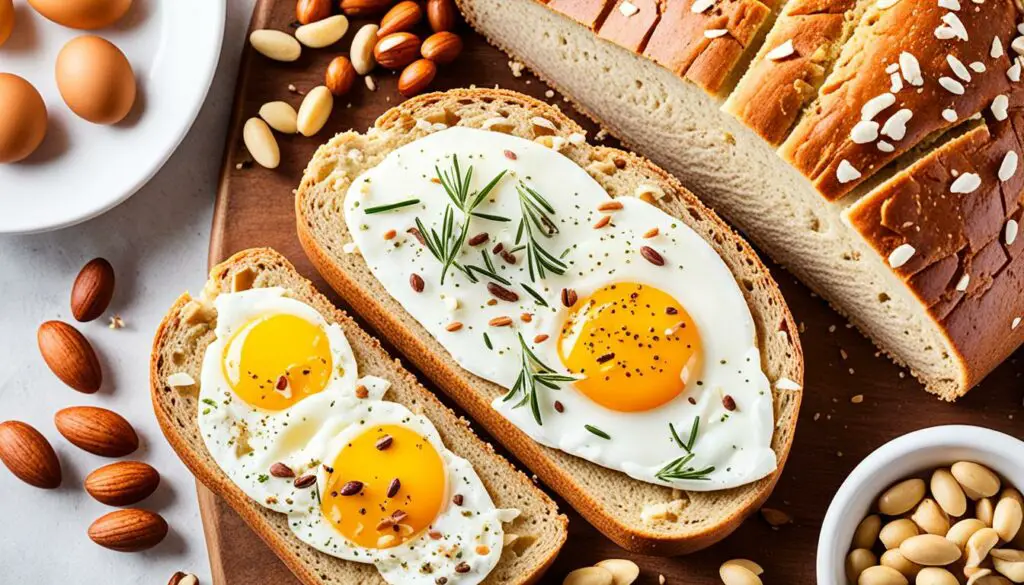
Not only do eggs add flavor and texture to bread recipes, but they also provide essential nutrients that contribute to a balanced diet. Eggs are highly nutritious, containing vitamins and proteins that are beneficial to our overall well-being.
Eggs are a rich source of protein, which is essential for the growth and repair of body tissues. Adding eggs to bread recipes increases the protein content, making the bread a more satisfying and nutritious option. Protein is also important for building and maintaining strong muscles and supporting a healthy immune system.
In addition to protein, eggs are a natural source of calcium, which is vital for healthy bones and teeth. Calcium plays a crucial role in maintaining bone density and strength. Including eggs in bread recipes can help boost your calcium intake and support optimal bone health.
Eggs are also a good source of vitamin D, which is essential for the absorption of calcium and phosphorus. Vitamin D is primarily obtained through sun exposure, but incorporating eggs into bread recipes can contribute to your daily vitamin D intake. Adequate vitamin D levels are important for bone health, immune function, and overall well-being.
Vitamin B12 is another nutrient found in eggs. It is necessary for proper red blood cell formation, neurological function, and DNA synthesis. Including eggs in bread recipes can help ensure an adequate intake of vitamin B12, especially for those following a vegetarian or vegan diet who may be at risk of deficiency.
Eggs are also a source of Omega 3 fatty acids, which are essential fats that have numerous health benefits. Omega 3 fatty acids are known for their anti-inflammatory properties and their role in brain health. Incorporating eggs into bread recipes can provide a small but valuable amount of Omega 3 fatty acids.
Overall, the nutritional benefits of using eggs in bread recipes are significant. Eggs offer a range of essential nutrients, including protein, calcium, vitamin D, vitamin B12, and Omega 3 fatty acids. Adding eggs to bread not only enhances the flavor and texture but also boosts its nutritional value. By incorporating eggs into your bread recipes, you can create delicious, wholesome loaves that contribute to a healthy and balanced diet.
Alternatives to Eggs in Bread Recipes

While eggs are a common ingredient in bread recipes, there are alternatives available for those who cannot or choose not to use them. These alternatives can achieve similar effects and allow for flexibility in creating delicious bread without relying on eggs. Here are some substitute ingredients that you can try:
1. Other Fats
Instead of eggs, you can use other fats like butter or oils to make the dough light and fluffy. These fats contribute to the texture of the bread and can provide moisture and richness to the final product.
2. Sugar and Milk
Sugar and milk can act as substitutes for eggs in terms of texture and moisture. Adding sugar can help retain moisture in the bread, while milk contributes to a softer texture. These ingredients can enhance the overall quality of your bread recipe.
3. Tangzhong, Potato Starch, or Cornflour
For the bounciness and chewiness that eggs contribute, you can consider using alternative ingredients like tangzhong, potato starch, or cornflour. These ingredients can help achieve a similar texture and enhance the overall structure of the bread.
Experimenting with these alternatives can open up new possibilities in your bread recipes and cater to different dietary preferences or restrictions. Whether you choose to use eggs or explore substitutes, it’s important to adapt the recipe and adjust other ingredients accordingly to achieve the desired results.
Exploring alternative ingredients can lead to exciting variations in your bread recipes. Remember to consider your specific needs and preferences when deciding whether to use eggs or substitutes. With these alternatives, you can create delicious and satisfying bread that meets your dietary requirements and culinary preferences.
The Influence of Eggs on Dough Handling
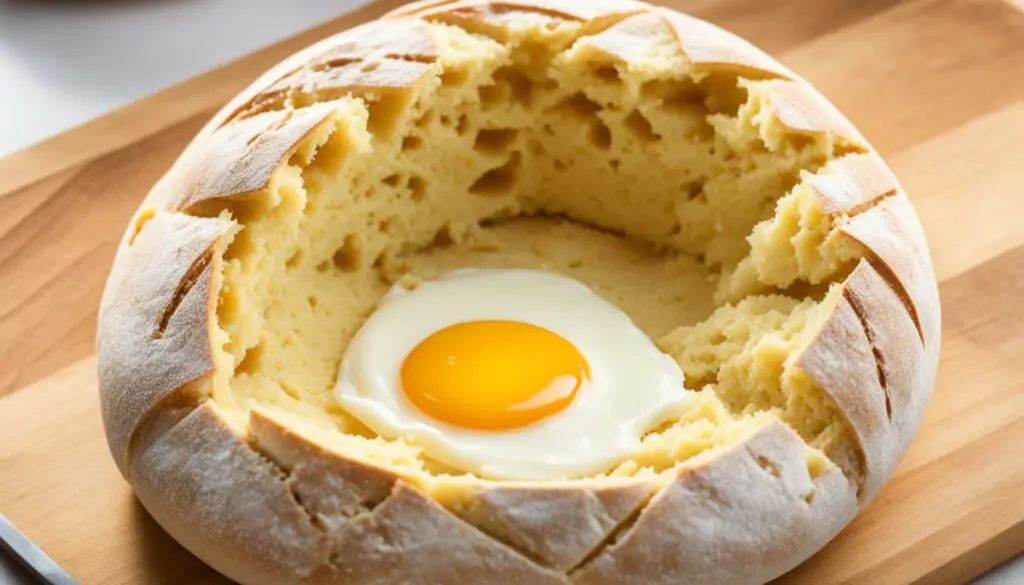
Adding eggs to bread dough can have a significant impact on how the dough is handled during the baking process. Understanding these effects and using appropriate techniques can help bakers achieve the desired results.
When eggs are incorporated into bread dough, whether in the form of whole eggs or egg yolks, the dough tends to become stickier. This increased stickiness can make the kneading and shaping processes more challenging.
In addition, doughs with a higher egg content, especially wet doughs, can pose additional handling difficulties. The presence of eggs can make the dough more delicate and prone to tearing or collapsing.
However, there are several helpful tips and tricks that bakers can employ to counteract the challenges posed by eggs in dough handling:
- Adjusting hydration: By making slight adjustments to the hydration level of the dough, bakers can achieve a better balance between the added moisture from the eggs and the desired consistency for easy handling. This can involve gradually adding small amounts of flour while kneading until the dough reaches the desired texture.
- Using specific folding methods: Folding techniques like the stretch and fold method or the coil fold method can help strengthen the dough structure while incorporating the eggs. These methods also contribute to better gluten development, resulting in improved handling characteristics.
- Chilling the dough: Refrigerating the dough for a short period before handling can help firm it up and make it easier to work with. This can be particularly beneficial when dealing with doughs that have a high egg content or a high-fat content, as chilling helps to solidify the fats and reduce stickiness.
Expert Tip:
“For stickier doughs containing eggs, I highly recommend lightly oiling your hands or using a dough scraper to prevent excessive sticking. This will make the kneading and shaping processes much smoother and more enjoyable.”
– Chef Julia Rodriguez
By implementing these tips, bakers can handle egg-enriched dough more effectively and achieve the desired texture and appearance in their breads.
| Challenge | Tip |
|---|---|
| Increased stickiness | Adjust hydration and add small amounts of flour while kneading |
| Delicate and tear-prone dough | Use specific folding methods to strengthen the dough structure |
| Difficulty in handling wet doughs | Chill the dough to firm it up before handling |
The Science Behind Eggs in Bread
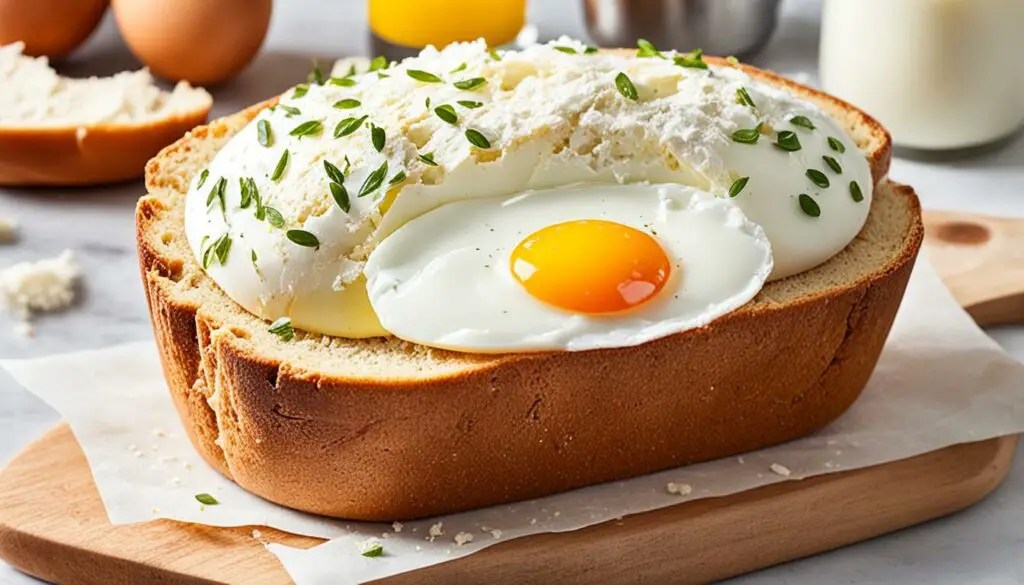
Eggs play a vital role in the scientific processes that occur during bread baking. Understanding the science behind eggs in bread allows bakers to manipulate various factors to achieve desired outcomes.
Protein Enhancements
The proteins in eggs contribute to the gluten structure of bread dough, resulting in a better rise and lighter texture. This occurs through the strengthening of the gluten network and its enhanced ability to retain gas. The proteins provide the necessary structure for the bread to rise, creating an airy and tender crumb.
Fat Impacts
The fat found in egg yolks tenderizes the gluten, resulting in a soft and moist crumb. It adds richness and creates a more indulgent texture, making each bite a delight. The fat content contributes to the overall appeal and mouthfeel of the finished bread.
Maillard Reactions and Caramelization
By including eggs in bread recipes, bakers can influence the Maillard reactions and caramelization that occur during baking. These reactions give bread a beautiful golden brown crust and enhance the flavors, making each slice incredibly delicious. Eggs contribute to the overall appearance and taste of the finished product.
Understanding the science behind eggs in bread empowers bakers to harness the benefits of eggs, resulting in bread with exceptional texture, flavor, and visual appeal.
| Benefits of Eggs in Bread | Variations in Egg Bread Recipes |
|---|---|
|
|
|
|
The Practical Experiment: Bread with and without Eggs
A practical experiment comparing bread with and without eggs can provide firsthand insights into the effects of eggs on the final product. By making two batches of bread using the same ingredients, except for the presence or absence of eggs, we can observe the impact that eggs have on the texture, crust color, and flavor of the bread.
For this experiment, we followed a standard bread recipe and divided the dough into two equal portions. One batch contained eggs, while the other did not. The dough was then shaped and baked using the same temperature and baking time for both loaves.
“The experiment revealed notable differences between the bread with and without eggs,” says Chef Sandra.
The observations from the experiment confirmed the importance of eggs in enhancing the quality of bread:
- Texture: The bread with eggs exhibited a lighter and softer texture compared to the one without eggs. The presence of eggs contributed to a more tender crumb, creating a pleasant eating experience.
- Crust Color: The bread with eggs had a golden brown crust that looked more appealing and appetizing. The eggs played a significant role in achieving the desired crust color and caramelization.
- Flavor: The bread with eggs had a richer and more flavorful taste. The eggs added depth and complexity to the overall flavor profile, enhancing the enjoyment of the bread.
Overall, the results of the practical experiment emphasized the importance of eggs in bread recipes. Eggs contribute not only to the texture and appearance but also to the taste and overall quality of the bread. Their presence ensures a delightful eating experience and a more satisfying loaf of bread.
The Role of Eggs in Bread Recipes
Eggs have a multifaceted role in bread recipes, contributing to texture, flavor, moisture, and overall quality. By understanding the importance of eggs, bakers can create delicious bread recipes that meet their desired outcomes.
Eggs enhance the gluten structure of bread dough, resulting in lighter and fluffier loaves. The proteins in eggs strengthen the gluten network, allowing the dough to rise better and create a more elastic texture. This translates to a softer and more delightful eating experience.
“Eggs are not only essential for gluten development, but they also improve the ability of the dough to retain gas, leading to a lighter and fluffier loaf.”
In addition to improving texture, eggs also have a significant impact on the crust of bread. They contribute to the browning and caramelization process, resulting in a delectable crust with enhanced flavors. The inclusion of eggs in bread recipes lends richness and depth to the crust, making each bite a truly satisfying experience.
Furthermore, eggs play a vital role in providing moisture to bread. Their natural emulsifying properties help to retain moisture throughout the baking process, resulting in a soft and moist crumb. This moistness not only affects the texture of the bread but also prolongs its shelf life, ensuring that each slice remains fresh and delicious for longer.
Beyond texture and moisture, eggs also contribute to the overall flavor profile of bread. The yolk, in particular, adds a hint of richness and depth to the taste, creating a more satisfying and enjoyable eating experience. Whether it’s a simple sandwich or a hearty loaf, the addition of eggs elevates the flavor of bread to new heights.
Benefits of Using Eggs in Bread:
- Improved gluten structure for lighter and fluffier loaves
- Enhanced browning and caramelization of the crust
- Moisture retention for a soft and moist crumb
- Added richness and depth of flavor
To illustrate the benefits of using eggs in bread, here’s a comparison table:
| Bread with Eggs | Bread without Eggs |
|---|---|
| Lighter and fluffier texture | Denser texture |
| Rich and flavorful crust | Less pronounced crust |
| Soft and moist crumb | Dry crumb |
| Enhanced eating experience | Less satisfying overall |
As shown in the table, the addition of eggs in bread recipes results in numerous benefits that contribute to the overall quality and enjoyment of the bread. From texture to flavor, eggs play a crucial role in creating delicious bread that keeps us coming back for more.
Conclusion
Eggs are a crucial ingredient in bread recipes, imparting numerous benefits that elevate the final product. They play a significant role in enhancing the gluten structure, resulting in a lighter and fluffier texture that bread enthusiasts adore. Moreover, eggs contribute to the overall flavor profile, adding richness to both the crumb and crust. But their advantages don’t end there.
In addition to the desirable taste and texture enhancement, eggs bring vital nutrients to bread recipes. Packed with protein, calcium, vitamin D, vitamin B12, and Omega 3 fatty acids, they contribute to a well-rounded and nutritious diet. Incorporating eggs into your bread recipes can be an excellent way to boost the nutritional content of your homemade loaves.
While there are alternatives available for individuals who cannot or choose not to use eggs in their bread recipes, it’s important to recognize the unique benefits that eggs offer. By understanding the effects of eggs on bread, bakers can experiment with different variations and techniques to create delightful, flavorful loaves that not only satisfy the palate but also fulfill essential nutritional needs.
FAQ
Why are eggs essential in bread recipes?
Eggs enhance the texture, flavor, and overall quality of bread. They contribute to a lighter and fluffier texture, inhibit gluten formation, and create a bouncier crumb. Eggs also add richness and flavor to enriched dough.
How do eggs affect the structure of bread dough?
Eggs increase the protein content in dough, which strengthens the gluten network and creates a more elastic texture. The fat in egg yolks inhibits gluten formation, resulting in a looser and more expandable dough. The egg whites act as a coagulant and set the crumb, making it bouncier and chewier.
What is the impact of eggs on the crust of bread?
Eggs contribute to the browning and caramelization of the crust, resulting in a crispier and more flavorful exterior. The yolk adds the most flavor to the crust. However, breads with eggs should not be baked at high temperatures to prevent excessive darkening.
What are the nutritional benefits of using eggs in bread?
Eggs are a rich source of protein, calcium, vitamin D, vitamin B12, and Omega 3 fatty acids. Including eggs in bread recipes adds essential nutrients that support bone health, immune function, and overall well-being.
What are the alternatives to using eggs in bread recipes?
Other fats like butter or oils, as well as sugar and milk, can be used as substitutes for eggs. Ingredients like tangzhong, potato starch, or cornflour can also provide similar effects in terms of texture and moisture.
How do eggs influence dough handling in bread recipes?
Doughs with eggs tend to be stickier, making kneading and shaping more challenging. However, adjustments in hydration or specific folding methods can alleviate these challenges and help achieve the desired results.
What is the science behind eggs in bread?
Eggs strengthen the gluten network, enhance the dough’s ability to retain gas, and tenderize the crumb. They also play a role in the Maillard reactions and caramelization during baking, leading to a golden brown crust and enhanced flavors.
What can a practical experiment comparing bread with and without eggs reveal?
Such an experiment can show the differences in texture, crust color, and flavor between breads with and without eggs, providing firsthand insights into the effects of eggs on the final product.
What is the role of eggs in bread recipes?
Eggs contribute to the texture, flavor, moisture, and overall quality of the bread. They enhance the gluten structure, create lighter and fluffier loaves, and improve dough handling. Additionally, eggs add richness and browning to the crust.

